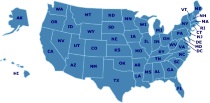Elementary Science
Young children learn science best by living and exploring the world around them. Come and get some great resources, tips, and ideas for teaching elementary-aged children science and discovery.
Elementary Science Teaching Tips & Ideas
How I Teach a Large Family in a Relaxed, Classical Way: Science
Family style learning is a great way to tackle lots of different subjects, including science.
Things to See & Do in Nevada
Great Basin National Park
From the sagebrush at its alluvial base to the 13,063-foot summit of Wheeler Peak, Great Basin National Park includes streams, lakes, alpine plants, abundant wildlife, a variety of forest types including groves of ancient bristlecone pines, and numerous limestone caverns, including beautiful Lehman Caves.
Elementary Science Activities & Experiments
ExploraVision
ExploraVision is a competition for all students in grades K-12 attending a school in the U.S., Canada, U.S. Territory or a Department of Defense school. Homeschooled students are eligible to enter. It is designed to encourage students to combine their imagination with their knowledge of science and technology to explore visions of the future. Teams of students select a technology, research how it works and why it was invented, and then project how that technology may change in the future. They must then identify what breakthroughs are required for their vision to become a reality and describe the positive and negative consequences of their technology on society. Winning ideas have focused on things as simple as ballpoint pens and as complex as satellite communications. The student teams write a paper and draw a series of Web page graphics to describe their idea. Regional winners make a Web site and a prototype of their future vision.
Arbor Day National Poster Contest
Join over 74,000 fifth grade classrooms and home schools across America in the Arbor Day National Poster Contest. The theme chosen will increase your students’ knowledge of how trees produce and conserve energy. The free Activity Guide includes activities to use with fifth grade students to teach the importance of trees in producing and conserving energy. These activities correlate with National Science and Social Study Standards. The Guide also includes all of the information you need for poster contest participation.
Elementary Science Curriculum
Christian Kids Explore Chemistry
These user-friendly, unabashedly Christian, one-year science curriculums for elementary students include teaching lessons, coloring pages, hands-on time, memorization lists, review sheets, creative writing assignments, and a supplemental book list. The Chemistry text is intended for grades 4-8, and includes such hands-on activities as making model atoms, breaking covalent bonds, and making gas expand. It also lists chemistry terms, notations, and rules. The conversational style gives students the basic information they need, making this an ideal first course in life science, especially useful for those following a classical approach.
Featured Resources
As an Amazon Associate, we earn from qualifying purchases. We get commissions for purchases made through links on this site.
Pass Your California DMV Test Guaranteed! 50 Real Test Questions! California DMV Handbook
This book contains the 50 most common questions and answers to the California DMV Written Test. Written by a former DMV classroom instructor and test creator, this straight forward book tells you the most likely questions and answers that will appear on you exam. Typically, at least 70-80% of the questions you encounter will come from these high frequency questions. Pass your test today!
MCP PLAID Phonics
MCP PLAID Phonics from Modern Curriculum Press incorporates best practices for teaching essential phonemic awareness and phonics skills with lots of flexibility. Find information on these products here.
Responsible Driving, Student Edition
This easy-to-read book features explanations of safe driving techniques and is used in many states as a textbook for in-class driving instruction. It is a great learning tool for a new driver and a good refresher for the more experienced driver.
Flip Over Math Manipulatives
Grades 1-5. Tub of over 500 manipulatives includes Pattern Blocks, Connecting People, Cuisenaire Rods, Coins, and Bean Counters and can be used with the Flip Over Math Books. This 49 page book (others sold separately) is written to NCTM Standards and provide hands on activities from basic math skills to advanced problem solving.
Phonics Pathways
Phonics Pathways begins with short-vowel sounds, slowly progressing to whole words, phrases, and sentences of gradually increasing complexity. Special teaching tips, extensive examples, and 100% decodable practice readings reinforce each lesson. Contains all spelling rules with a spelling index, spelling charts, spelling short-cuts, diacritical markings, and a wealth of inspirational proverbs. The new 9th edition of Phonics Pathways features many new enhancements including a wealth of reproducib...



